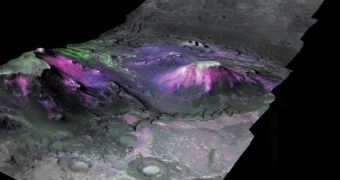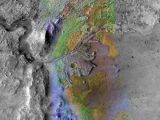Mars had liquid water on the surface in its distant past and quite a lot of it too, according to the high-resolution spectrometry images relayed back to Earth by the CRISM instrument on board NASA's Mars Reconnaissance Orbiter. CRISM revealed that there is a great abundance of clay minerals, which usually form in the presence of water, and if Mars did indeed support life the best place to look for evidence would be these clay deposits.
Ever since the 1970s, images sent back by spacecrafts indicated that some of the channels and canyons on the surface of the Red Planet could have been created by liquid water. However, mineralogical investigations have only just recently begun to support this theory. Most of the previous spacecrafts were equipped with instruments that operated only at long wavelengths and low resolutions and were good at mapping the planet's surface, which is mostly made of basaltic materials and dust.
In 2006, three years after it entered orbit around the Red Planet, the Mars Express spacecraft found evidence of clays for the first time, with the help of its high-resolution OMEGA instrument, suggesting that in its first 500 million years the planet would have been able to support liquid water. However, the resolution of OMEGA was still too low to resolve small structures and make detailed observations, a problem that has now been solved with the CRISM instrument on board NASA's MRO.
"We can really see individual outcrops of rocks. We've seen a lot more hydrated minerals, and a lot more occurrences of them than observed with OMEGA. It suggests that the alteration of the surface of Mars in the ancient past was more extensive than we may have previously thought," says Ralph Milliken of NASA's Jet Propulsion Laboratory, part of the research team analyzing the data received from the CRISM instrument.
More than half of the surface of Mars has been mapped so far with the help of the CRISM instrument, and there appears to have been significant amounts of liquid water, even if not enough to support oceans. "But we had water that was flowing over the surface and it was happening long enough to change things like basalt into clay minerals and had enough time to carve out channels and fluvial networks," he said.
Some argue that these channels would have existed only for small amounts of time, maybe only for several thousands of years in the aftermath of frequent asteroid impacts, while others suggest that liquid water would have stayed on the surface of Mars long enough for life to appear. Evidence of the presence of clay mineral has even been found in craters, in regions that would have been buried some 5 kilometers under the surface before the impact.
Milliken says that these clays could have been created after the crater, or they might have been present there before the impact and have been exposed afterwards.
"Water must have been creating minerals at depth to get the signatures we see," he added, but until the data produced by CRISM and OMEGA is combined, researchers can't tell for sure the location where these clays originally formed. Previous observations carried out by Bethany Ehlmann with the CRISM instrument around geological features such as deltas for example, were successful in finding clay minerals while OMEGA had failed to find any at all.
"Visually these features look for all the world like the Mississippi delta, where you'd expect to see lots of mud and clay. We see clay minerals exactly in the spots you'd expect to see them," Milliken says.
"If any micro-organisms existed on ancient Mars, the watershed would have been a great place to live," Ehlmann said, suggesting that potential evidence of life on Mars could be found in these clay deposits. The good news is that the future robotic mission to the Red Planet's surface will be a rover and the landing site hasn't been yet chosen, thus it has a fairly good chance of studying clay deposits in the future.

 14 DAY TRIAL //
14 DAY TRIAL // 
